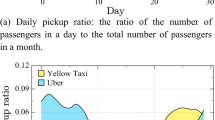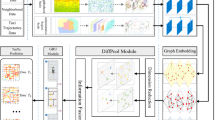Abstract
Taxi demand prediction in a city is a highly demanded smart city research application for better traffic strategies formulation. It is essential for the interest of the commuters and the taxi companies both to have an accurate measure of taxi demands at different regions of a city and at varying time intervals. This reduces the cost of resources, efforts and meets the customers’ satisfaction at its best. Modern predictive models have shown the potency of Deep Neural Networks (DNN) in this domain over any traditional, statistical, or Tensor-Based predictive models in terms of accuracy. The recent DNN models using leading technologies like Convolution Neural Networks (CNN), Graph Convolution Networks (GCN), ConvLSTM, etc. are not able to efficiently capture the existing spatio-temporal characteristics in taxi demand time-series. The feature aggregation techniques in these models lack channeling and uniqueness causing less distinctive but overlapping feature space which results in a compromised prediction performance having high error propagation possibility. The present work introduces Spatio-Temporal Aggregator Predictor (ST-AGP), a DNN model which aggregates spatio-temporal features into (1) non-redundant and (2) highly distinctive feature space and in turn helps (3) reduce noise propagation for a high performing multi-step predictive model. The proposed model integrates the effective feature engineering techniques of machine learning approach with the non-linear capability of a DNN model. Consequently, the proposed model is able to use only the informative features responsible for the objective task with reduce noise propagation. Unlike, existing DNN models, ST-AGP is able to induce these qualities of feature aggregation without the use of Multi-Task Learning (MTL) approach or any additional supervised attention that existing models need for their notable performance. A considerable high-performance gain of 25 − 37% on two real-world city taxi datasets by ST-AGP over the state-of-art models on standard benchmark metrics establishes the efficacy of the proposed model over the existing ones.











Similar content being viewed by others
Notes
A common operation over each element of a sequence is presented using an arrow with common operands and operation denoted above and below arrow sign.
Kaggle “Taxi Fare Challenge”, 2017
References
Tong Y, Chen Y, Zhou Z, Chen L, Wang J, Yang Q, Ye J, Lv W (2017) The simpler the better: a unified approach to predicting original taxi demands based on large-scale online platforms. In: Proceedings of the 23rd ACM SIGKDD international conference on knowledge discovery and data mining, p 1653–662
Jiang R, Song X, Fan Z, Xia T, Chen Q, Miyazawa S, Shibasaki R (2018) Deepurbanmomentum: an online deep-learning system for short-term urban mobility prediction. In: AAAI, p 784–791
Kuang L, Hua C, Wu J, Yin Y, Gao H (2020) Traffic volume prediction based on multi-sources gps trajectory data by temporal convolutional network. Mob Netw Appl 25(4):1405–1417
Kuang L, Zheng J, Li K, Gao H (2021) Intelligent traffic signalcontrol based on reinforcement learning with state reduction for smart cities. ACM Trans Int Technol (TOIT) 21(4):1–24
Huang X, Ye Y, Wang C, Yang X, Xiong L (2021) A multi-mode traffic flow prediction method with clustering based attention convolution lstm. Applied Intelligence, p 1–14
Zhang Y, Yang Y, Zhou W, Wang H, Ouyang X (2021) Multi-city traffic flow forecasting via multi-task learning. Applied Intelligence, p 1–19
Tu Y, Lin S, Qiao J, Liu B (2021) Deep traffic congestion prediction model based on road segment grouping. Applied Intelligence, p 1–23
Chiabaut N, Faitout R (2021) Traffic congestion and travel time prediction based on historical congestion maps and identification of consensual days. Transp Res Part C Emerg Technol 124:102920. https://doi.org/10.1016/j.trc.2020.102920
Geng X, Li Y, Wang L, Zhang L, Yang Q, Ye J, Liu Y (2019) Spatiotemporal multi-graph convolution network for ride-hailing demand forecasting. In: Proceedings of the AAAI conference on artificial intelligence, vol 33, p 3656–3663
Yu B, Yin H, Zhu Z (2017) Spatio-temporal graph convolutional networks:, A deep learning framework for traffic forecasting. arXiv:1709.04875
Tan H, Wu Y, Shen B, Jin PJ, Ran B (2016) Short-term traffic prediction based on dynamic tensor completion. IEEE Trans Intell Transp Syst 17(8):2123–2133
Lee S, Fambro DB (1999) Application of subset autoregressive integrated moving average model for short-term freeway traffic volume forecasting. Transp Res Rec 1678(1):179–188
Kumar SV, Vanajakshi L (2015) Short-term traffic flow prediction using seasonal arima model with limited input data. Eur Transp Res Rev 7(3):21
Chandra SR, Al-Deek H (2009) Predictions of freeway traffic speeds and volumes using vector autoregressive models. J Intell Transp Syst 13(2):53–72
Ren J, Xie Q (2017) Efficient od trip matrix prediction based on tensor decomposition. In: Mobile Data Management (MDM), 2017 18th IEEE International Conference On, p 180–185. IEEE
Bhanu M, Mendes-Moreira J, Chandra J (2020) Embedding traffic network characteristics using tensor for improved traffic prediction. IEEE Transactions on Intelligent Transportation Systems, p 1–13
Wang Y, Yin H, Chen H, Wo T, Xu J, Zheng K (2019) Origin-destination matrix prediction via graph convolution: a new perspective of passenger demand modeling. In: Proceedings of the 25th ACM SIGKDD international conference on knowledge discovery & data mining, pp 1227–1235
Yu B, Yin H, Zhu Z (2018) Spatio-temporal graph convolutional networks: A deep learning framework for traffic forecasting. IJCAI, p 3634–3640
Zhou X, Shen Y, Zhu Y, Huang L (2018) Predicting multi-step citywide passenger demands using attention-based neural networks. In: Proceedings of the Eleventh ACM international conference on web search and data mining, p 736–744
Zhao L, Song Y, Zhang C, Liu Y, Wang P, Lin T, Deng M, Li H (2020) T-gcn: A temporal graph convolutional network for traffic prediction. IEEE Trans Intell Trans Syst 21(9):3848–3858. https://doi.org/10.1109/TITS.2019.2935152
Liu P, Qiu X, Huang X (2017) Adversarial multi-task learning for text classification. In: Proceedings of the 55th annual meeting of the association for computational linguistics
Priya S, Upadhyaya A, Bhanu M, Kumar Dandapat S, Chandra J (2020) Endea: Ensemble based decoupled adversarial learning for identifying infrastructure damage during disasters. In: Proceedings of the 29th ACM international conference on information & knowledge management, p 1245–1254
Bhanu M, Mendes-Moreira J, Chandra J (2020) Embedding traffic network characteristics using tensor for improved traffic prediction IEEE Transactions on Intelligent Transportation Systems
Yao H, Liu Y, Wei Y, Tang X, Li Z (2019) Learning from multiple cities: a meta-learning approach for spatial-temporal prediction. In: The world wide web conference, p 2181–2191
Kuang L, Gong T, OuYang S, Gao H, Deng S (2020) Offloading decision methods for multiple users with structured tasks in edge computing for smart cities. Futur Gener Comput Syst 105:717–729
Liu Y, Liu C, Lu X, Teng M, Zhu H, Xiong H (2017) Point-of-interest demand modeling with human mobility patterns. In: Proceedings of the 23rd ACM SIGKDD international conference on knowledge discovery and data mining, p 947–955. ACM
Moreira-Matias L, Gama J, Ferreira M, Mendes-Moreira J, Damas L (2013) Predicting taxi–passenger demand using streaming data. IEEE Trans Intell Transp Syst 14(3):1393–1402
Beiraghi M, Ranjbar A (2011) Discrete fourier transform based approach to forecast monthly peak load. In: 2011 Asia-Pacific power and energy engineering conference, p 1–5. IEEE
Lee S, Fambro D (1999) Application of subset autoregressive integrated moving average model for short-term freeway traffic volume forecasting. In: Transportation research record:, journal of the transportation research board (1678), p 179–188
Lv Y, Duan Y, Kang W, Li Z, Wang FY (2015) Traffic flow prediction with big data: a deep learning approach. IEEE Trans Intell Transp Syst 16(2):865–873
Kumar SV, Vanajakshi L (2015) Short-term traffic flow prediction using seasonal arima model with limited input data. Eur Trans Res Rev 7(3):21
Trasarti R, Guidotti R, Monreale A, Giannotti F (2017) Myway: Location prediction via mobility profiling. Inf Syst 64:350– 367
Hoang MX, Zheng Y, Singh AK (2016) Fccf: forecasting citywide crowd flows based on big data. In: Proceedings of the 24th ACM SIGSPATIAL international conference on advances in geographic information systems, p 1–10
Tan H, Feng G, Feng J, Wang W, Zhang YJ, Li F (2013) A tensor-based method for missing traffic data completion. Trans Res Part C:, Emerg Technol 28:15–27
Liu J, Musialski P, Wonka P, Ye J (2012) Tensor completion for estimating missing values in visual data. IEEE Trans Pattern Anal Mach Intell 35(1):208–220
Niesing J (1997) Simultaneous Component and Factor Analysis Methods for Two or More groups: a Comparative Study vol 1997. DSWO Press, Leiden University leiden: The Netherlands ???
Zhang J, Zheng Y, Qi D (2017) Deep spatio-temporal residual networks for citywide crowd flows prediction. In: Thirty-first AAAI conference on artificial intelligence
Deng D, Shahabi C, Demiryurek U, Zhu L, Yu R, Liu Y (2016) Latent space model for road networks to predict time-varying traffic. In: Proceedings of the 22nd ACM SIGKDD international conference on knowledge discovery and data mining, p 1525–1534
Zhu Y, Zhang W, Chen Y, Gao H (2019) A novel approach to workload prediction using attention-based lstm encoder-decoder network in cloud environment. EURASIP J Wirel Commun Netw 2019(1):1–18
Hamilton W, Ying Z, Leskovec J (2017) Inductive representation learning on large graphs. In: Advances in neural information processing systems, p 1024–1034
Seo Y, Defferrard M, Vandergheynst P, Bresson X (2018) Structured sequence modeling with graph convolutional recurrent networks. In: International conference on neural information processing, p 362–373. Springer
Lin K, Xu X, Gao H (2021) Tscrnn: a novel classification scheme of encrypted traffic based on flow spatiotemporal features for efficient management of iiot. Comput Netw 190:107974
Koochali A, Schichtel P, Dengel A, Ahmed S (2019) Probabilistic forecasting of sensory data with generative adversarial networks–forgan. IEEE Access 7:63868–63880
Zheng C, Fan X, Wang C, Qi J (2020) Gman: a graph multi-attention network for traffic prediction. In: Proceedings of the AAAI conference on artificial intelligence, vol 34, pp 1234–1241
Householder AS (1958) Unitary triangularization of a nonsymmetric matrix. J ACM (JACM) 5 (4):339–342
Stewart GW (1980) The efficient generation of random orthogonal matrices with an application to condition estimators. SIAM J Numer Anal 17(3):403–409
Kipf TN, Welling M (2016) Semi-supervised classification with graph convolutional networks. arXiv:1609.02907
Azzouni A, Pujolle G (2017) A long short-term memory recurrent neural network framework for network traffic matrix prediction. arXiv:1705.05690
Toqué F, Côme E, El Mahrsi MK, Oukhellou L (2016) Forecasting dynamic public transport origin-destination matrices with long-short term memory recurrent neural networks. In: 2016 IEEE 19th international conference on intelligent transportation systems (ITSC), p 1071–1076. IEEE
Bhanu M, Priya S, Dandapat SK, Chandra J, Mendes-Moreira J (2018) Forecasting traffic flow in big cities using modified tucker decomposition. In: International conference on advanced data mining and applications, p 119–128. Springer
Bhanu M, Chandra J, Mendes-Moreira J (2018) Enhancing traffic model of big cities: Network skeleton & reciprocity. In: Communication Systems & Networks (COMSNETS), 2018 10th International Conference On, p 121–128. IEEE
Zhao L, Song Y, Zhang C, Liu Y, Wang P, Lin T, Deng M, Li H (2019) t-gcn: A temporal graph convolutional network for traffic prediction IEEE Transactions on Intelligent Transportation Systems
Yao H, Wu F, Ke J, Tang X, Jia Y, Lu S, Gong P, Ye J, Li Z (2018) Deep multi-view spatial-temporal network for taxi demand prediction. In: Thirty-second AAAI conference on artificial intelligence
Acknowledgements
This work is funded by Scheme for Promotion of Academic and Research Collaboration (SPARC) under Ministry of Human Resource Development, India, within project code P1506.
Author information
Authors and Affiliations
Corresponding author
Additional information
Publisher’s note
Springer Nature remains neutral with regard to jurisdictional claims in published maps and institutional affiliations.
Rights and permissions
About this article
Cite this article
Bhanu, M., Priya, S., Moreira, J.M. et al. ST-AGP: Spatio-Temporal aggregator predictor model for multi-step taxi-demand prediction in cities. Appl Intell 53, 2110–2132 (2023). https://doi.org/10.1007/s10489-022-03475-7
Accepted:
Published:
Issue Date:
DOI: https://doi.org/10.1007/s10489-022-03475-7




